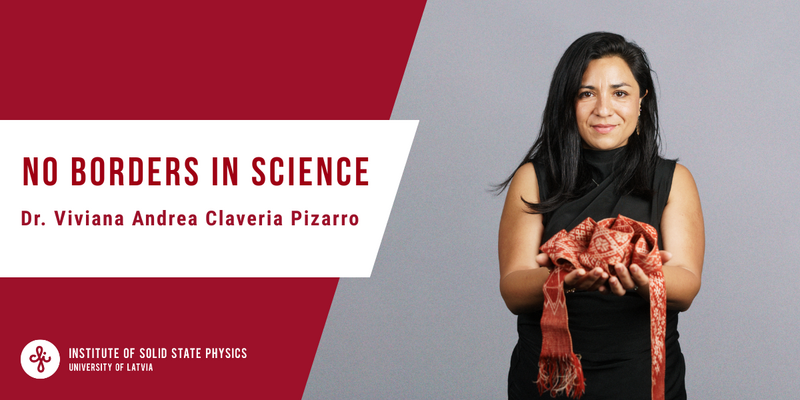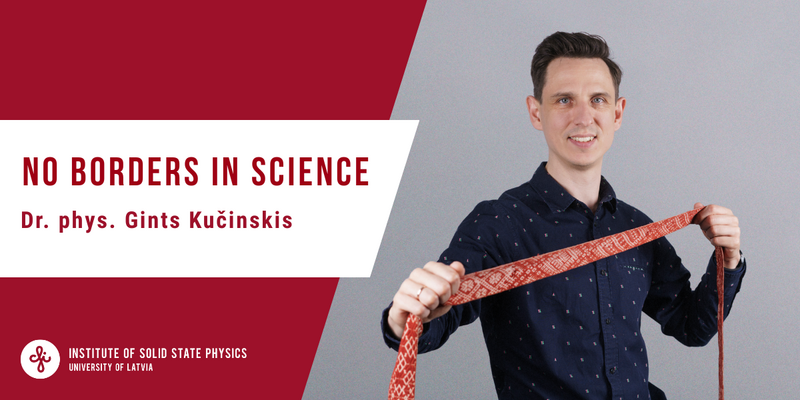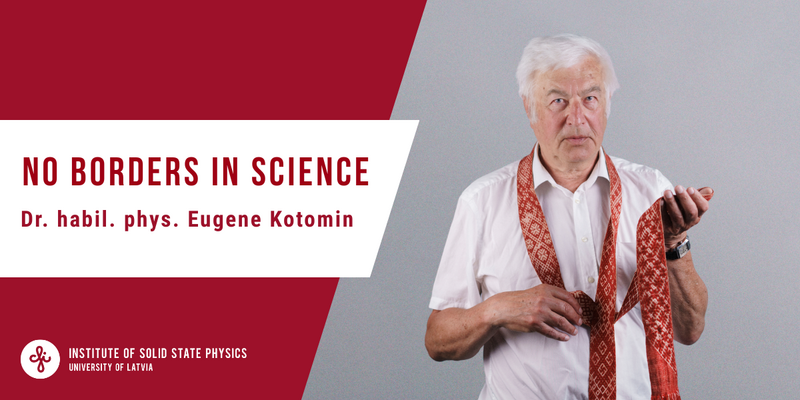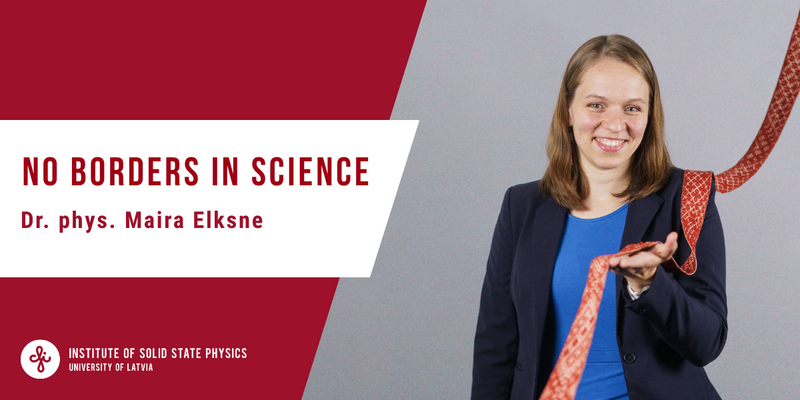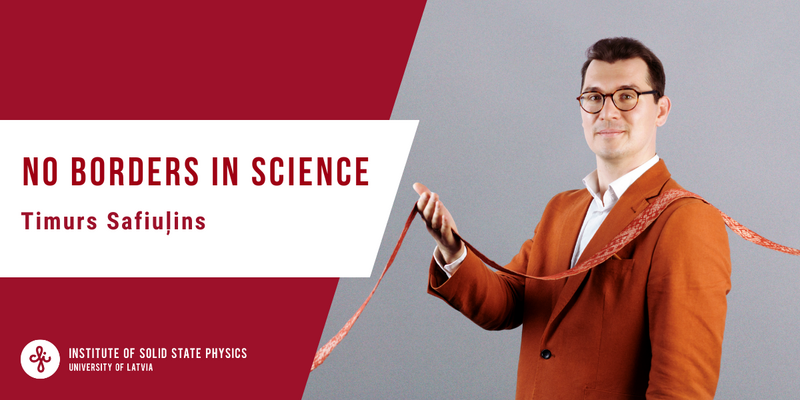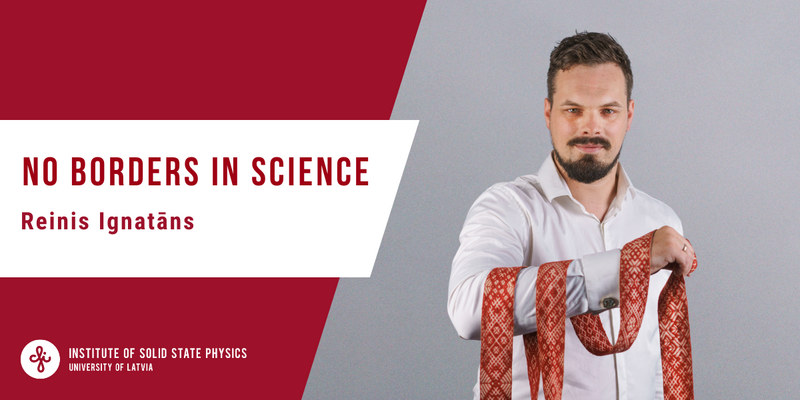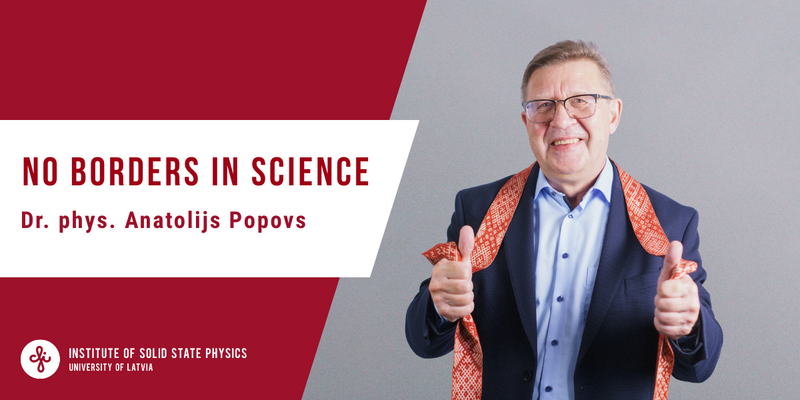NO BORDERS IN SCIENCE – Dr. Viviana Andrea Claveria Pizarro
No Borders in Science is a series of interviews with Institute of Solid State Physics (ISSP UL) scientists and employees who are closely connected to the world outside of Latvia – by birth, attained education, or just their daily work. Through their stories we want to highlight the institute as a part of the global scientific network – a centre of excellence where collaboration isn’t limited by geography and the exchange of ideas, experiences, and efforts is placed at the forefront. This time, we speak with Viviana Andrea Claveria Pizarro about how her journey in science flowed from lasers manipulating tiny particles to biophysics and working to fight life-threatening blood diseases.
In your own words, what is your scientific specialty? What are your topics of interest outside of it?
Today my work is divided into two main areas. On one side, I’m developing medical devices that address blood flow disorders and improve diagnostic capabilities, with the aim of creating tools that are effective, accessible, and reliable in clinical use.
On the other side, I focus on fundamental science. My research explores the behavior of biofluids, especially how red blood cells and other microscopic entities move through the bloodstream. Building on this, I’m now studying how bacteria navigate in flow, to learn how nature has optimized mechanisms for reaching precise sites in the body. Together with colleagues, we are “programming” bacteria by carefully editing their DNA, in order to optimize their movement toward cancer sites. All of this is done using microfluidic chips developed at ISSP UL, which allow us to mimic blood-like conditions. It’s a complex challenge, but it opens exciting opportunities to understand and eventually harness these natural navigation strategies for autonomous cancer site detection.
How did your journey in science start? How did it lead to ISSP UL?
I’m a physicist-engineer by training. In the beginning, I was drawn to theory and worked on optics, helping to develop a new method to trap particles in an optical tweezer together with Albert Ferrando from the University of Valencia. During a mandatory internship to finish my physicist-engineering studies in Valencia, I unexpectedly had the chance to take a class on replicating bacteria. It was my first encounter with synthetic biology – completely new to me coming from pure physics – and it sparked my curiosity in biophysics.
When I was looking for a PhD, I first explored opportunities in Chile but eventually expanded my search abroad. I applied for a joint program between Germany and France and was accepted. That’s where I truly entered biophysics: working with red blood cells and using optical tweezers experimentally for the first time; previously, my work had been only theoretical. At the same time, I began working with microfluidics, building systems that mimic capillaries, arteries, and venules, exactly the kind of research I continue today.
Over time, I realized that all the basic knowledge about red blood cells and blood flow behaviour can be applied to improve current medical devices or develop new ones. My engineering side perked up. This led me travel to the USA to work with Dr. David Ku at Georgia Tech in the development of a point-of-care device to assess the thrombolytic state of patients. This was during the COVID-19 pandemic. During this time, I also joined the Engineer Core of the RADx program launched by the NIH, gaining invaluable experience in manufacturing processes, device assessment, and a deep dive into human factors, workflows, and organizational challenges.
After that chapter and a period in Chile working with bacteria for the first time, I came to ISSP UL. Even though my work doesn’t fit neatly under “solid state physics,” the institute has an openness to interdisciplinarity that allows me to connect physics, engineering, and medicine, bringing these ideas to life here.
In three words, could you describe work at the ISSP UL and life in Latvia?
Passion. I am deeply passionate about my work, and I feel extremely happy here because I can truly be myself. I have the freedom to propose ideas – scientific or developmental – and pursue them with creativity. My colleagues bring their own strong passion and energy. They are young, highly skilled, and full of drive, which I find both inspiring and motivating.
Excellence. There is an excellent team of professionals here, all willing to work toward the best in every aspect – product development, communication, science, new ideas, and support. This shared pursuit of excellence makes the environment both stimulating and rewarding.
Opportunity. To transform ideas into reality, funding is essential. Here in Latvia, there are many opportunities available, and being part of the European Union opens even more doors.
How do you feel the ISSP UL assists scientists in participating in events and capitalising on other growth and networking opportunities?
The institute was very supportive of my participation at the ISTH 2025 Congress in June this year, where I had the honour of giving a talk. This was my first “mission” abroad as a member of ISSP UL, and it showed me how much the institute helps scientists take part in international events and grow through networking. During the Congress, many colleagues from around the world asked me “Why Latvia?” and I was proud to share what makes ISSP UL unique: its broad set of tools, strong international reputation, culture of excellence, and dynamic scientific community. As an experimentalist, I particularly value the access to advanced equipment and the opportunities to collaborate with other experimentalists in Latvia. People were enthusiastic about visiting us, and some are already engaged with me in joint funding applications.
You have already submitted projects for FLPP and BioPHOT and are gearing up to submit to ERC – could you speak on the research support system the ISSP UL has provided in these initiatives?
It has been an excellent experience. Not every institution is so committed to helping researchers prepare the strongest possible project applications. In many places, you are expected to handle everything on your own. At ISSP UL, however, the process is very well organized – you feel supported, and you know you are not alone. There is a real sense of community, which is perfect for me as a team-oriented researcher. When I first arrived, I had plenty of ideas but needed guidance on where to apply for funding. Together with the Institute, we mapped out the opportunities, whether Latvian or European, and from the very beginning I felt incredibly well supported.
What is your next career goal?
My next career goal is very clear: to strengthen and advance my own research lines. I feel like every scientist aspires to develop their own lab and be recognized for their contributions, and that is what I am working toward. At the moment, my projects sometimes require support from outside the institute. While collaboration is invaluable, it can also be challenging to organize and to travel elsewhere just to complete a single experiment. Looking ahead, I want to build more of that capacity within ISSP UL and make the Institute known for the research I am leading. Our Micro and Nano Device Laboratory already has a strong reputation, and I am determined to further expand and develop this renown.
Beyond that, I want to devote the next ten years and more to doing truly good science. For me, this means pursuing discoveries that are exciting, unique, and transformative – work that answers fundamental questions while, on the applied side, contributing to tools and technologies that help us live in a better world.
NO BORDERS IN SCIENCE – Dr. phys. Gints Kučinskis
No Borders in Science is a series of interviews with Institute of Solid State Physics (ISSP UL) scientists and employees who are closely connected to the world outside of Latvia – by birth, attained education, or just their daily work. Through their stories we want to highlight the institute as a part of the global scientific network – a centre of excellence where collaboration isn’t limited by geography and the exchange of ideas, experiences, and efforts is placed at the forefront. This time, we speak with Gints Kučinskis about accruing expertise on energy materials from the world’s sharpest minds and being a driving force in the changes you want to see.
In your own words, what is your scientific specialty? Any topics of interest outside of it?
As the world moves towards more sustainable energy generation and storage, I contribute by creating materials and processes for next-generation energy storage. I lead a research lab focused on Li-ion and Na-ion batteries, developing and improving electrode materials, as well as studying the ageing of materials and battery components. Our laboratory also explores complementary energy technologies, such as hydrogen generation. In addition to core scientific tasks, such as planning experiments, supervising researchers, and writing scientific papers, I also generate ideas and develop them into competitive project applications.
How did your journey in science lead outside of Latvia?
My journey in energy storage materials began at ISSP UL where I wrote my bachelor’s thesis, during a time when battery research in Latvia was re-emerging. I continued working here until my PhD studies, when I had the valuable opportunity to deepen my expertise on battery materials at the Max Planck Institute for Solid State Research in Stuttgart, supported by a scholarship from the Deutsche Bundesstiftung Umwelt.
After completing my PhD, it was clear to me that I wanted to continue expanding my knowledge. At that point, continuing my career abroad was not only an exciting opportunity – it was also essential in order to gain broader experience, collaborate internationally, and work with advanced research infrastructure that wasn’t yet readily available in Latvia. Research funding opportunities were also limited at home, particularly for early-career researchers.
I therefore spent another 3 and a half years as a postdoctoral researcher at the Max Planck Institute, where I worked in high-level research environment, developed new skills, and built a professional network that I continue to benefit from today.
And what led you back to the Institute of Solid State Physics?
Returning to Latvia and ISSP UL was certainly not an easy decision at the time. The opportunity to continue working in the field I am passionate about, while being close to friends and family and maintaining academic freedom was a strong motivating factor.
Despite the uncertainties and limited resources back then, over time, thanks to many extra hours of work and, undoubtedly, support from colleagues and family, I was able to secure additional funding, significantly expand the team, and now lead a laboratory of over 25 people focused on the development of battery materials and hydrogen energy technologies.
Admittedly, between when I left for Germany in 2015 and now, the research environment in Latvia and at ISSP UL has improved significantly. We now work with modern equipment, have good institutional support, and an increasingly international outlook. Our lab hosts and trains not only Latvian students and researchers but also talents from abroad and has many successful international collaborations with Latvian and European research institutes and companies. So much so, that my past-self would certainly be very envious of the opportunities that students and young professionals today have at ISSP UL.
If there is one thing this experience has taught me, it's to never underestimate your ability to shape your environment and drive meaningful change.
How does the ISSP UL assist scientists (proliferating participation in projects and events, supporting funding acquisition, endorsing growth opportunities, etc.)?
ISSP UL provides a supportive environment for researchers by ensuring strong administrative assistance and allowing scientists to focus on the substance of their work as much as possible within our project-driven system. The institute encourages participation in international projects and events, actively supports funding acquisition, and promotes professional growth. Importantly, there is a culture of practicality here which I facilitate as much as I can – decisions and support are guided by what makes sense and what helps drive progress.
Currently, what is your next goal – in science, career-wise, or just in general?
My current goal is to continue building a strong, motivated research team and to further strengthen the ecosystem working on energy storage – both within ISSP UL and beyond. I hope to see some of our innovations successfully transition from the lab into real-world industrial applications, where they can make a tangible impact.
NO BORDERS IN SCIENCE – Dr. habil. phys. Eugene Kotomin
No Borders in Science is a series of interviews with Institute of Solid State Physics (ISSP UL) scientists and employees who are closely connected to the world outside of Latvia – by birth, attained education, or just their daily work. Through their stories we want to highlight the institute as a part of the global scientific network – a centre of excellence where collaboration isn’t limited by geography and the exchange of ideas, experiences, and efforts is placed at the forefront. This time, we speak with Eugene Kotomin about the energy that courses through his work and the possibilities that being open to cooperation brings.
What are the specifics of your work and how does it include collaboration with foreign scientists?
I am a theoretician, modelling new advanced materials, mostly for energy applications – batteries, fuel cells, hydrogen production, optical windows for fusion reactors, etc. International collaboration for us is key for success; first, we use the latest and the most efficient computer codes developed in Italy and Austria. Second, we have access to foreign supercomputers. Third, it helps to be at the cutting edge of the actual problems. I have worked in many countries (USA, Canada, Italy, Denmark, Russia, Kazakhstan), and for the last 25 years – mostly in Germany. In all cases, our expertise was very complementary and mutually beneficial, e.g. in the Max Planck Institute for Solid State Physics we performed and now continue the modelling and prediction of new advanced proton conducting cathodes and electrolytes for new types of fuel cells which were synthesised and measured by local experimentalists, with a focus on understanding the reaction mechanisms which hardly could be determined experimentally. Such computer-supported cooperation permits us to optimally develop new efficient materials and devices.
What would you name as the strengths of the ISSP UL?
Our Institute is one of the European leaders in materials science, with great accumulated expertise, as well as in theoretical modelling where we’re open for fruitful cooperation.
In your experience, how does the ISSP UL promote international cooperation?
One of the most efficient ways is international projects (e.g. COST, Horizon, ERA NET) where several research groups from different countries complement each other. Currently, we are involved in several such projects, e.g. we theoretically model and predict materials, Slovenian partners synthesize these nanomaterials, while Taiwanese partners test the efficiency of photostimulated hydrogen production. As a result of this cooperation, we’ve suggested new efficient photocatalysers and published high rank papers.
How does the ISSP UL assist scientists – foreign and home-grown (proliferating participation in projects and events, supporting funding acquisition, endorsing growth opportunities, etc.)?
Young scientists are more than welcome to participate in most research projects – this is even a precondition for receiving grants from the Latvian Council of Science. To my mind, if financially supported by the Ministry of Education and Science, ISSP UL could become a research centre where young international researchers on stipends can come for several months to do joint research. In the beginning of my carrier, I was in one such Interdisciplinary Materials Centre at the University of Western Ontario, Canada which gave me a very good start.
NO BORDERS IN SCIENCE – Dr. phys. Maira Elksne
No Borders in Science is a series of interviews with Institute of Solid State Physics (ISSP UL) scientists and employees who are closely connected to the world outside of Latvia – by birth, attained education, or just their daily work. Through their stories we want to highlight the institute as a part of the global scientific network – a centre of excellence where collaboration isn’t limited by geography and the exchange of ideas, experiences, and efforts is placed at the forefront. This time, we speak with Maira Elksne about bringing know-how from abroad back home, as well as the importance of science producing real-world impact.
In your own words, what is your scientific specialty? Any topics of interest outside of it?
Nanofabrication – in short, it means creating structures and devices in the scale of nanometers (billion times less than a meter). I find it deeply inspiring to work on structures that can be infinitesimaly small yet are capable of driving major technological advances in, for example, electronics and quantum physics.
How did your journey in science lead outside of Latvia?
I went to study mathematics and physics in the UK for my bachelor’s because I’ve always been curious about the inner workings of the world. Encouraged by my project supervisor, I applied and got a scholarship PhD offer at Glasgow University to do nanofabrication and make Gallium nitride electronics at the James Watt Nanofabrication Centre, so I continued my studies there. During that time, I was also a teaching assistant in a Msc course on nanofabrication. Once my PhD was completed, I was offered to take over and teach that course, alongside continuing my research in nanofabrication, which I gladly accepted. Afterwards, I worked in two more semiconductor-electronics-based research projects – one of these projects was a great example of collaboration between industry and academia, so I emphasise the importance of such partnerships to this day.
And what led you back to the Institute of Solid State Physics?
I always wanted to move back to Latvia eventually, and when that plan was in motion and I started to look for jobs here, I was excited to find out that there is a cleanroom in Latvia – right here at ISSP UL. Of course, I wanted to utilise my expertise and continue my research, so I was very pleased that Latvia is among the countries making advances in this direction.
How does the ISSP UL assist scientists (proliferating participation in projects and events, supporting funding acquisition, endorsing growth opportunities, etc.)?
In my experience, ISSP UL is very encouraging when it comes to researchers participating in competitive research programmes where they provide administrative, legal and scientific support. They’re also very supportive of scientists partaking in conferences and networking opportunities that serve as avenues of growth for the scientists themselves, as well as new potential areas for the institute to explore.
Currently, what is your next goal – in science, career-wise, or just in general?
My next goal is to ensure that our scientific work leads to meaningful, real-world impact. As I previously said – I’ve seen first-hand what can happen when academia and science successfully collaborate with industry. That’s why I actively participate in initiatives like BioPhoT project calls where tangible results and business impact is prioritised from the get-go.
NO BORDERS IN SCIENCE – Timurs Safiuļins
No Borders in Science is a series of interviews with Institute of Solid State Physics (ISSP UL) scientists and employees who are closely connected to the world outside of Latvia – by birth, attained education, or just their daily work. Through their stories we want to highlight the institute as a part of the global scientific network – a centre of excellence where collaboration isn’t limited by geography and the exchange of ideas, experiences, and efforts is placed at the forefront. This time, we speak with Timurs Safiuļins about how to best assist researchers’ work and how valuable is good communication in the world of science.
In your own words, what is your specialty in the ISSP UL? Do you have any particular topics of interest in science?
I like to think of my job as helping scientists, and sometimes just giving them a little encouragement to keep going when the road feels long. No two days are the same. One moment I’m coordinating our scientific projects like SWEB and FeLow-D, the next I’m supporting new innovation proposals on all sorts of topics across our laboratories. I organise events, welcome international guests, and look for ways to expand our partner network. There’s a saying: The more languages you know, the more of a person you are. Same here, I just hope it doesn’t end up giving me a split personality!
As for science, I’m endlessly curious. My background is in economics, so working here often feels like stepping into a world full of wonders and magic. I’m especially fascinated by the practical side of research and the part where ideas make a real difference in the world. As a scuba diver, I have a soft spot for marine and underwater technologies, particularly robotics and underwater communication.
How did your journey lead outside of Latvia?
It all began in 2009, when I was still a bachelor’s student and joined the Erasmus programme to study at Ghent University. At the time, I couldn’t have imagined how often I’d return to Belgium in the years to come. After graduating, my career naturally moved into project management, mainly with an international focus. For a while, I spent nearly half my time travelling, eventually visiting every EU country. I represented Riga in several urban development networks, including Energy Cities and Eurocities, which gave me an incredible chance to experience working cultures beyond Latvia. Since 2018, I’ve also been part of the UN UNECE expert group. Collaborating with people from so many different countries has taught me to read between the lines of business culture, find common ground quickly, and focus on results. Every country has something to teach you, and there’s always a way to bring the best of those lessons back home.
And what led you back to the Institute of Solid State Physics?
Quite simply, a desire to do something meaningful for my country and its people. I believe that investing in science, especially in young scientists, is one of the most powerful ways to strengthen the national economy. I’m convinced that with the right effort, Latvia can earn a prominent place in the European scientific landscape. ISSP UL has everything it needs to achieve this, and our motto, Passion drives progress, really says it all.
How does the ISSP UL assist its employees (proliferating participation in projects and events, supporting funding acquisition, endorsing growth opportunities, etc.)?
In recent years, I’ve seen a real shift. This is the first workplace I’ve known where initiative is not just accepted but actively encouraged. We have a wonderfully diverse team with one shared goal, and we’re ready to help wherever it’s needed, from shaping a clear roadmap for an idea, to preparing the proposal itself, and even guiding it all the way from the laboratory to the market. I’m sure that ISSP UL is a place where you’re encouraged to grow, where the atmosphere is open, the collaboration is genuine, and the people make ideas come alive.
Currently, what is your next goal – career-wise or just in general?
Projects are my craft, so my short-term aim is to bring in new ERC and EIC Pathfinder grants for the ISSP UL. We’ll see which arrives first. Looking further ahead, I’d like to leave something lasting for science in Latvia. If I can’t forge an entirely new path, I’d like to share what I’ve learned – maybe by writing a practical guide to crafting successful project proposals, or a physics handbook for non-STEM readers… or perhaps both rolled into one.
NO BORDERS IN SCIENCE – Dr. chem. Anna Pidluzhna
No Borders in Science is a series of interviews with Institute of Solid State Physics (ISSP UL) scientists and employees who are closely connected to the world outside of Latvia – by birth, attained education, or just their daily work. Through their stories we want to highlight the institute as a part of the global scientific network – a centre of excellence where collaboration isn’t limited by geography and the exchange of ideas, experiences, and efforts is placed at the forefront. This time, we speak with Anna Pidluzhna about unravelling the mysteries of science and the value of a chemist in an institute of physics.
In your own words, what is your scientific specialty? Do you have any topics of interest outside of it?
By education and by passion, I’m a chemist working in two distinct fields: lithium-ion batteries, and LEECs and OLED technologies. What I find especially engaging about these areas is their deep connection to energy transformation. Whether it’s storing energy or converting it into light, the underlying chemistry is both complex and elegant – a fascinating combination to work with.
Outside my core research, I’m always curious about how systems function – from materials and machines to social dynamics and creative processes. Exploring how things work, in science or beyond it, is something that constantly inspires me.
How did your journey in science start?
My interest in science was sparked by a love of solving puzzles and uncovering what lies beneath the surface. I’ve always enjoyed reading, especially stories that require logic and persistence to uncover hidden truths. That mindset translated naturally into science: investigating phenomena, analysing data, and trying to understand complex systems.
What fascinated me early on – and still does – is that science isn’t just about finding answers, but about asking the right questions. That blend of structure, creativity, and discovery is what drew me in and continues to drive me forward.
What led you to ISSP UL?
My move to the Institute of Solid State Physics, University of Latvia came at the intersection of curiosity and opportunity. I was looking for a place where I could work on challenging materials science problems while being part of a supportive and interdisciplinary community. ISSP UL offers just that – with modern infrastructure, access to advanced equipment, and an environment that encourages collaboration and international exchange.
I’m currently part of the Horizon Europe project NoVOC (Grant No. 101069612), which aims to develop greener and more sustainable battery manufacturing technologies. Being part of such projects adds real-world relevance to my work and aligns closely with the institute’s mission.
How does the ISSP UL assist scientists (proliferating participation in projects and events, supporting funding acquisition, endorsing growth opportunities, etc.)?
The institute actively supports researchers in multiple ways – from helping identify suitable funding programs and facilitating international partnerships to providing opportunities to present research and grow professionally.
There’s also a culture of mentorship and openness here, which makes it easier to navigate complex projects or explore new ideas. ISSP UL encourages participation in collaborative research frameworks and offers practical support for conference travel, proposal writing, and skill development – all of which are essential for scientific growth.
Currently, what is your next goal – in science, career-wise, or just in general?
To not go into great scientific detail, I’ll just say that for my next goal I’m focused on deepening scientific excellence – mine and the institute’s – and the community influence of my work.
NO BORDERS IN SCIENCE – Ph.D. Reinis Ignatāns
No Borders in Science is a series of interviews with Institute of Solid State Physics (ISSP UL) scientists and employees who are closely connected to the world outside of Latvia – by birth, attained education, or just their daily work. Through their stories we want to highlight the institute as a part of the global scientific network – a centre of excellence where collaboration isn’t limited by geography and the exchange of ideas, experiences, and efforts is placed at the forefront. This time, we speak with Reinis Ignatāns about the passion and know-how needed when working to see that which cannot be seen with the naked eye.
In your own words, what is your scientific specialty? Any topics of interest outside of it?
My speciality is performing challenging in situ experiments with electron beam and X-ray instruments. My whole PhD thesis was based on applying an electric field inside of a transmission electron microscope (TEM) on focused ion beam (FIB) prepared specimens. I also enjoy theoretical calculations and experiment modelling. Recently, I have dipped my toes into wave optics and associated measurements – me and a student under my guidance created a table-top laser interferometer instrument capable of measuring oscillations with a resolution of approximately 1 pm in amplitude. This is a distance hundred million times smaller than the typical thickness of a singular human hair.
How did your journey in science lead outside of Latvia?
I got my Master’s degree from the University of Latvia, but I did not continue studying here to attain my PhD – to be honest, I was a little tired of studies, so I took a two-year break. In the meantime, I was actually still working here at ISSP UL, where I got delved ever deeper into the world of electron microscopy. This really helped me land a PhD position in Switzerland at the EPFL (École polytechnique fédérale de Lausanne) where I could spend a lot of time doing challenging, but fun experiments on various electron microscopes.
And what led you back to the Institute of Solid State Physics?
When I was doing my PhD studies, I met Līga who is now my wife – I owe coming back to Latvia to her, actually. Additionally, my friend Dr. Krišjānis Šmits knew that I was finishing my PhD studies and will be coming back to Latvia, so he offered me a position in the ISSP UL Laboratory of Microscopy – a deal that I gladly accepted.
In three words, describe how everyday work at the ISSP UL makes you feel.
Morning, blink, evening. I’m joking, of course, but it’s to illustrate that working at ISSP UL gives you a lot of opportunities to chase your interests and explore new possibilities so the days end up more than eventful.
How does the ISSP UL assist scientists (proliferating participation in projects and events, supporting funding acquisition, endorsing growth opportunities, etc.)?
The institute often holds organized seminars on various activities, for example, how to prepare successful grant project proposals and submissions. This is something that might be actually underappreciated here in ISSP UL as – speaking from personal experience – there are not many institutions organizing such events and seeking to assist researchers to such an extent.
Currently, what is your next goal – in science, career-wise, or just in general?
I recently became a father; therefore, my mind is preoccupied with raising a tiny human being. I would be happy if she grows to be as curious as me (or even more) – that would be a good achievement.
NO BORDERS IN SCIENCE – Dr. phys. Anatolijs Popovs
No Borders in Science is a series of interviews with Institute of Solid State Physics (ISSP UL) scientists and employees who are closely connected to the world outside of Latvia – by birth, attained education, or just their daily work. Through their stories we want to highlight the institute as a part of the global scientific network – a centre of excellence where collaboration isn’t limited by geography and the exchange of ideas, experiences, and efforts is placed at the forefront. This installment features Anatolijs Popovs who shares how the institute has grown into the collaborative and international environment it showcases today.
What are the specifics of your work and how does it include collaboration with foreign scientists?
For more than forty years, I have worked in various areas of solid-state physics, though during the past two decades my main research focus has been on radiation effects – studying how different materials and systems behave under radiation exposure. Over the years, I have led and initiated numerous projects at both the national level in Latvia and internationally, including the EUROfusion Enabling Research Projects. Many of these are large, collaborative efforts that unite research teams from several countries.
Collaboration with foreign scientists is truly at the core of my work. I have co-authored many joint papers with colleagues from Europe, the United States, Central Asia, and beyond. We frequently exchange data, discuss experimental results, and compare approaches to ensure that our findings are as accurate and comprehensive as possible.
Beyond research itself, I am also deeply involved in building and supporting the scientific community. I have organized and co-organized several international conferences, EMRS symposia, and international schools, all of which are a great chance not just to share ideas, but also to connect researchers across different disciplines and spark new projects.
In addition, I participate in several major international consortia and grant-funded projects, including those supported by different research programs such as Horizon Europe. These collaborations are an excellent way to combine resources, expertise, and technologies from multiple institutions, which allows us to make faster and more meaningful progress.
Overall, my work is inherently collaborative and international in nature. I strongly believe that science advances most effectively when it is pursued together – across borders, cultures, and perspectives.
What would you name as the strengths of ISSP UL?
In short, the foundation of our strength today is preserving the traditions and the high standards that have been developed and maintained over the past 50 years.
ISSP UL has several key strengths that make it a truly competitive and dynamic research center. First of all, the institute has a very strong tradition of fundamental and applied research in materials science and condensed matter physics. Over the years, it has developed deep expertise in areas such as functional materials, nanotechnology, photonics, and radiation effects – all supported by modern laboratories and advanced experimental facilities.
Another important strength is the highly qualified and internationally-connected research staff. Many of our scientists have long-term collaborations with leading universities and research centers across Europe, the United States, and Central Asia (e.g. Kazakhstan). This international environment encourages the exchange of ideas, mobility of researchers, and participation in large European consortia and projects like Horizon Europe and EUROfusion.
The institute is also very strong in combining basic research with practical applications. Many of our projects bridge the gap between science and industry, focusing on new materials and technologies that can be transferred to practical use. This makes our work relevant not only academically but also for innovation and technological development.
It’s important to reiterate that we’re not standing still – we’re always looking for new ideas and continuing to grow. In addition to our traditional research areas, we’re now focusing on ferrofluidics, biophotonics, and smart materials that already show real practical applications
Finally, I would highlight the supportive, creative atmosphere of the institute. There is a strong spirit of collaboration between different research groups and generations of scientists. Young researchers are actively involved in international projects and training programs, ensuring the continuity and growth of our scientific community. I can honestly say that young people today have wonderful support – something we couldn’t even dream of in the early ’90s.
In your experience, how does ISSP UL empower international cooperation?
ISSP UL really supports international cooperation in several ways. We take part in big projects and consortia like Horizon Europe and EUROfusion, which bring together teams from many countries. We also have long-term partnerships with universities and research centres worldwide, collaborate on papers, share data, and coordinate experiments.
On top of that, the institute organizes international conferences, workshops, and schools, giving researchers a chance to meet and start new collaborations. And researcher mobility is encouraged, so both young and senior scientists can gain international experience and bring fresh ideas back home – all they need is the desire to do it! Overall, ISSP UL makes international collaboration a natural part of everyday research.
How does ISSP UL assist scientists – foreign and home-grown (proliferating participation in projects and events, supporting funding acquisition, endorsing growth opportunities, etc.)?
We’re doing really well in this regard. ISSP UL supports both local and international scientists with lots of funding opportunities and helps us join projects and collaborations. It also offers workshops, schools, and conferences to develop skills, meet people, and share ideas. Overall, the Institute provides a supportive environment where researchers can grow, take on leadership roles, and thrive internationally.
